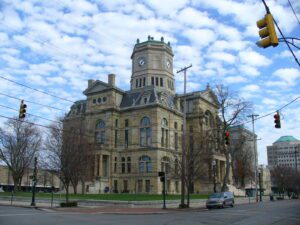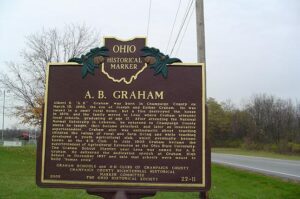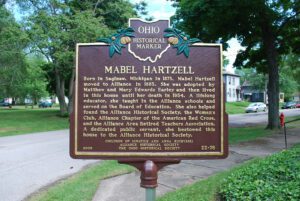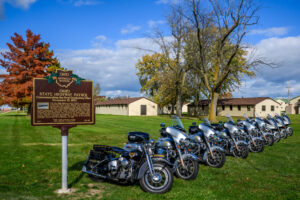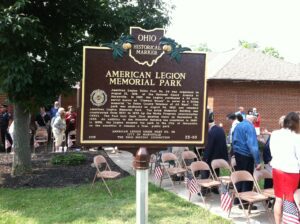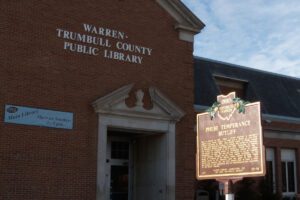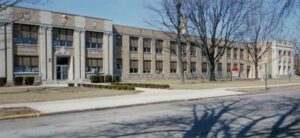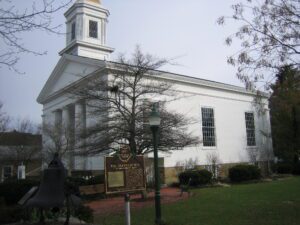, OH
Butler County was created on March 24, 1803, about three weeks after Ohio became a state. Hamilton won the competition for the county seat, thanks to Israel Ludlow, Hamilton’s founder. Ludlow’s donation of the public square secured the county seat. The first Butler County trial court met in July 1803 in a tavern before moving to a two-story military building located at what had been Fort Hamilton (1791-1796). The county built the first courthouse on this public square in 1810. The two-story stone building contained a jail on the first floor and a courtroom on the upper level. A new brick two-story courthouse was built on this square in 1817 at a cost of $10,000. A four-sided clock was added to the top of the building in 1837. (continued on other side)
, OH
Albert B. “A.B.” Graham was born in Champaign County on March 13, 1868, the son of Joseph and Esther Graham. He was raised in a small rural home, but a fire destroyed the house in 1879, and the family moved to Lena where Graham attended local schools, graduating at age 17. After attending the National Normal University in Lebanon, he returned to Champaign County where he taught, then became principal, and later an innovative superintendent. Graham also was enthusiastic about teaching children the values of rural and farm living and while teaching developed a youth agricultural club, which eventually became known as the 4-H Club. In July 1905 Graham became the superintendent of Agricultural Extension at the Ohio State University. The Graham School District near Lena was named for A.B. Graham. He delivered the dedication speech at Graham High School in December 1957 and said that schools were meant to build “human souls.”
, OH
Born in Saginaw, Michigan in 1875, Mabel Hartzell moved to Alliance in 1883. She was adopted by Matthew and Mary Edwards Earley and then lived in this house until her death in 1954. A lifelong educator, she taught in the Alliance schools and served on the Board of Education. She also helped found the Alliance Historical Society, the Woman’s Club, Alliance Chapter of the American Red Cross, and the Alliance Area Retired Teachers Association. A dedicated public servant, she bestowed this house to the Alliance Historical Society.
, OH
This location marks the site where the first Ohio State Highway Patrol cadet class graduated on November 15, 1933. Known as the Camp Perry School, Colonel Lynn Black opened the training on October 3, 1933, after House Bill 270 created the Division. Colonel Black received over 5,000 applications for the inaugural class, which was trimmed to approximately 125 individuals who formed the first training class. The Ohio National Guard graciously volunteered the use of this facility for the training. The newly formed Highway Patrol purchased 54 new motorcycles to be used for patrol duties. Many of the cadets had no prior experience operating motorcycles and had to be trained in short order. Cadets faced extreme adversity, including frigid temperatures and a lack of heating in the facilities. Severe weather shortened training for the cadets. The first class of 60 new Patrolmen graduated on November 15, 1933.
The Ohio State Highway Patrol’s core values are instilled into all new recruits and continually reinforced. They are the foundation upon which a trooper can be a consummate public servant; Adaptability, Attention to Detail, Diversity, Family, Honesty, Officer Safety, Performance Driven, Professionalism, Self-Discipline, Sense of Urgency and Team Oriented.
, OH
American Legion Union Post No. 79 was organized on August 21, 1919, at the National Guard Armory in Marysville. In 1927, the Legion purchased a 24 acre parcel known as “Clement Woods” to serve as a living memorial “to Union County Veterans of All Wars”. The park was dedicated on August 24, 1927, and renamed American Legion Memorial Park. The brick Memorial Building was constructed from 1937 to 1938 by the Works Progress Administration (WPA). The Post held their first meeting there on September 12, 1938. An addition to the Memorial Building was completed in 1960. In 1989, the Legion donated the park to the City of Marysville on the condition it remains a free, public park.
, OH
Born in Warren in 1859, Phebe T. Sutliff received a Bachelor’s degree from Vassar College in 1880 and a Master of Arts from Cornell University in 1890. Miss Sutliff taught at Hiram College in Ohio and Rockford College in Illinois and served as President of Rockford College from 1896 until 1901. Returning to Warren, she turned her attention to civic matters. During World War I, she started an evening school of citizenship classes for foreign immigrants. In 1924, she was the first woman to run for Congress in her district. Elected as the first woman president of the Board of Trustees of the Warren Public Library in 1938, Phebe Sutliff served in this capacity until her death in 1955. Miss Sutliff was inducted into the Ohio Women’s Hall of Fame in 1990. Her legacy to the community was the establishment and endowment of the Sutliff Museum.
, OH
The North Baltimore Elementary and High School stood at 124 S. Second St. and was dedicated November 11, 1927. The tan and brown brick building replaced a school (built 1884) that a fire destroyed on January 26, 1926. The new school building, for children in grades 1-12, also included classrooms for home economics and business courses, as well as a 900-seat auditorium (including balcony), second floor cafeteria, gymnasium, administrative offices, and a public library. E.E. Leidy was the school’s superintendent and R. Vern Northup was the high school principal. The members of the board of education were Dr. E.A. Powell, President, D.B. Bushey, Vice President, C.G. Nigh, Clerk, and Nellie Roberts and R.E. Simon. Previously known as the “Independents,” the school’s sports teams became the “Tigers” in 1931. (Continued on other side)
, OH
In 1804 a group of neighbors in Granville, Massachusetts and Granby, Connecticut formed The Licking Company for the purpose of moving to “Newlands” in Ohio. Inspired and informed by the settlement of Worthington in 1803, the Company purchased 29,040 acres in the U.S. Military District. Advance parties surveyed and mapped a site, established a mill, and planted grain. The Company planned a public square, a school, library, quarry, burying ground, and property for the support of churches. In November and December 1805, some 150 emigrants in ox-drawn wagons arrived in their new home and built temporary shelters on the designated public square. On December 9 through 12 1805, Company members selected their Granville lots in an auction that was described as peaceable and honest.


